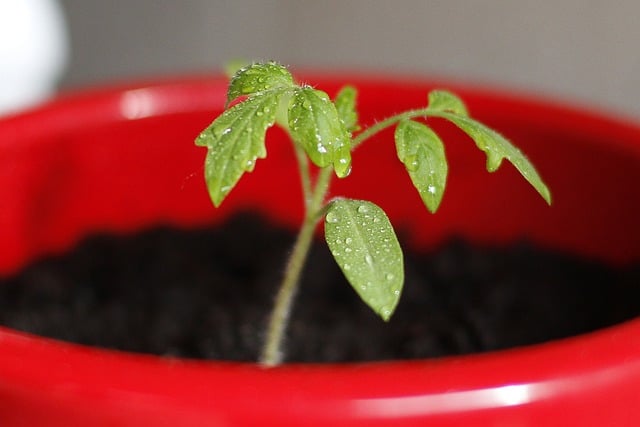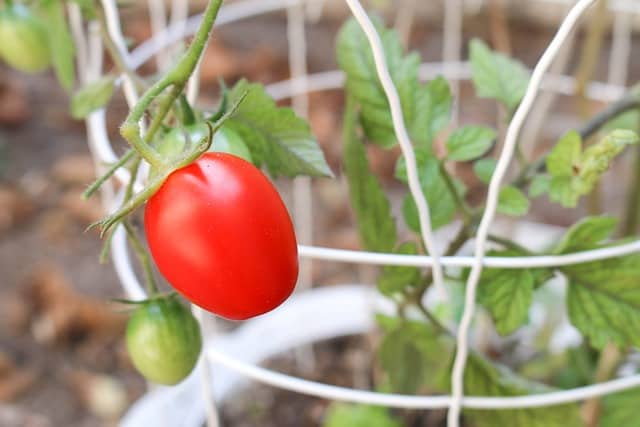
Growing your own fruits and vegetables can be a rewarding hobby, but sometimes space is limited. If you have a small balcony or patio, that doesn’t mean you can’t enjoy fresh tomatoes this season.
With a little bit of effort and patience, you can learn how to grow tomatoes on a balcony with ease.
In this blog, we’ll guide you through the process of growing tomatoes in containers and pots, selecting the right soil, providing proper support, and troubleshooting common problems.
By the end of this article, you’ll be ready to start your own mini tomato garden and enjoy the taste of homegrown tomatoes all summer long!
In short, this is how to grow tomatoes on a balcony: Choose determinate tomato varieties and containers with good drainage and place these in sunlight. Ensure well-drained, fertile, and slightly acidic soil. Use slow-release fertilizers and water frequently. Lastly, prune regularly to direct energy towards fruit production.
Introduction: Growing Tomatoes on a Balcony
Growing tomatoes on a balcony is a fun and rewarding way to enjoy fresh produce right at home. Tomatoes come in various colors, sizes, and shapes, and can even be used as an ornamental plant for your balcony.
While all tomato varieties are suitable for container gardening, it is best to choose determinate varieties that do not spread too much or become too tall for your small space.
It is important to plant your tomatoes in well-drained and stable pots or planters, then to place them in the sunniest spot on your balcony.
Tomatoes require fertile soil that is slightly acidic and well-drained, so be sure to add compost or well-rotted manure to your potting mix.
Don’t forget to fertilize your plants often and water them regularly to ensure a bountiful harvest! [1]
Best Types of Tomato Varieties for Balconies and Container Gardening
When it comes to growing tomatoes on a balcony or/and in containers, it’s important to choose the right variety. Generally, determinate varieties are the best choice since they don’t grow too tall and are more compact.
Cherry tomatoes, for example, are an excellent option for growing on balconies, as they’re low-maintenance, easy to grow, and produce a lot of fruit in a growing season. Other suitable types of tomatoes for balconies include Patio, Roma, and bush types.
It’s important to choose varieties that are locally available and proven to have been successfully grown in containers. Doing so will ensure that your tomato plants will thrive and produce a bountiful harvest that’s both delicious and satisfying to grow. [4]
These are some of the best tomato varieties to grow on a balcony:
| Tomato Variety | Characteristics and Why They’re Suitable for Balconies |
| Patio Princess | Determinate, compact plant; small fruit size; ideal for small containers |
| Tiny Tim | Dwarf, compact plant; cherry-sized fruit; perfect for hanging baskets |
| Window Box Roma | Compact, bushy plant; small to medium fruit size; great for small spaces |
| Tumbling Tom | Trailing, cascading plant; cherry-sized fruit; perfect for hanging baskets or cascading over the edge of a container |
| Husky Cherry Red | Determinate, compact plant; cherry-sized fruit; ideal for small to medium containers |
Note: These tomato varieties are great for balconies because they are either determinate or dwarf plants that won’t grow too tall or spread too much, making them perfect for small containers and limited spaces. They also produce small to medium-sized fruit, which is ideal for balcony gardens.
The Tumbling Tom variety is a trailing plant that can be grown in hanging baskets or cascaded over the edge of a container, making it a great option for vertical gardening on a balcony.
Choosing the Right Container Size and Placement
Choosing the right container size and placement is crucial to growing healthy balcony tomatoes. While all tomato varieties are suitable for container gardening, it’s important to pick a pot/planter size that will accommodate the plant’s root system. One plant per pot is also a good approach.
A minimum of a 12-inch deep and wide container is recommended, but a larger container of at least 18 inches or larger is better. There are many designs and styles to choose from, here are some popular planters for balconies.
When it comes to placement, tomatoes require full sun, so it’s important to place them in the sunniest position on your balcony.
Keep in mind that large amounts of fruit and stems can cause the containers to topple in the wind, so it’s important to choose a stable pot and stabilize it with sturdy support if necessary. This is also true if you decide to grow cucumbers on your balcony as well.
By choosing the right container size and placement, you’ll give your balcony tomatoes the best chance for success. [6]
Here’s a video with awesome tips on how to grow tomatoes on a balcony:
Preparing Fertile Soil and Potting Mix for Tomato Plants
Preparing fertile soil is crucial when it comes to growing healthy tomato plants. When planting tomatoes in pots on a balcony, it’s important to choose a high-quality potting mix that is well-drained and nutrient-rich.
Regular garden soil is too dense for potted plants and can lead to soil-borne diseases.
Mix compost or aged manure into the potting soil to give the tomatoes the essential nutrients they need to thrive. The ideal pH range for growing tomatoes is between 6.0 to 6.8. A soil test kit can help determine the pH level of your soil.
For hard water, mix in peat moss to help lower the pH level. Providing the right kind of soil (with moisture in the soil) can increase the success of growing tomatoes in a balcony garden. [7][8]
Planting Tomatoes from Seeds or Potted Plants

Planting tomatoes on a balcony can be done from seeds or potted plants. Starting from seeds requires patience and time as it takes a few weeks for them to germinate. Potted plants, on the other hand, are readily available and offer a quicker option.
Determinate tomatoes require less space, so they are suitable for smaller containers, even a window box can work, while indeterminate varieties grow taller and need a larger pot to grow on the balcony.
Sow seeds or transplant the plants into a premium quality potting mix that allows good drainage and aeration.
After planting, you’ll need to make sure the tomatoes receive enough amount of sunlight of at least six hours of sun daily and keep the soil consistently moist (you’ll need to water, but be careful not to give excess water!).[10]
Caring for Tomato Plants: Watering, Fertilizing, and Removing Suckers
Caring for tomato plants on a balcony is essential for a bountiful harvest. Regular watering is crucial as balconies tend to be windier than regular gardens. They need moist soil to grow well, so check the soil regularly, and water them at least once or twice a day on hot summer days.
However, wet leaves may cause blight and other fungal diseases, so it’s recommended to water them in a way that doesn’t soak their leaves. Fertilizing is also important, as tomatoes are heavy feeders.
Even if slow-release fertilizer is already applied, it’s best to feed them later when there’s more foliage growth but fewer fruits or flowers. It’s recommended to fertilize once a week or two, depending on the plant’s needs. Removing suckers during the growth period is also important, as they drain the plant’s nutrition. [12]
Key Tips for Growing Healthy Tomatoes on Your Balcony
Growing healthy tomato plants on a balcony requires some special care:
- First, select the right tomato container – the pot should have drainage holes, and be made of a light-colored material.
- Choose a dwarf variety of tomato that’s suitable for growing in containers.
- The plant needs plenty of sunlight, so position the containers in a sunny spot on the balcony alone or together with other plants that love sunlight.
- Water the plant regularly and deeply, but be careful not to get water onto the leaves.
- Support the plant with a stake or trellis to encourage upward growth. Fertilize the plant with slow-release fertilizer at planting time and again after it starts bearing fruit (more on fertilizers below).
- Prune the plant to remove diseased leaves and suckers to promote good air circulation.
Ideal Climate Conditions and Sunlight Requirements for Tomatoes

Growing container tomatoes on a balcony requires the right weather conditions. Tomatoes thrive in warm weather and need a long growing season to produce fruit. They require at least 6 hours of sunlight per day. If the balcony doesn’t get enough light, the plants may not develop properly and may not flower or fruit at all.
Tomatoes also prefer a warm and humid climate. The ideal temperature for tomato plants is between 65-85°F (18-29°C). Anything above 95°F (35°C) can lead to reduced fruit set and poor fruit quality. If the climate is too cold, the plants may not grow well and may develop diseases.
Balcony gardeners should protect their tomato plants from cold winds with a windbreak or cover. By providing the right climate and sunlight, it is possible to grow your own tomatoes (and they taste delicious because they’re your own!). [15]
Tomatoes Maintenance: Issues and Solutions, Harvest Time, and Fertilizer Application
Tomatoes on a balcony require maintenance to keep them healthy and productive. Some common issues with growing tomatoes on a balcony are pests and diseases. Look out for yellowing leaves, spots, and wilting. If you notice these issues, remove the affected leaves and increase air circulation around the plants.
Harvest time is when the tomatoes are fully ripened, usually when they turn red. Pick them by twisting them gently or cutting them from the stem with pruning shears.
To ensure good growth and yield, add fertilizer to the soil periodically. Use a balanced fertilizer with equal amounts of nitrogen, phosphorus, and potassium. Read the label for application instructions, and avoid over-fertilizing as this can lead to poor growth and nutrient burn, and they might dry out more quickly. [20]
Endnote on How to Grow Tomatoes on a Balcony

In conclusion, growing tomatoes on a balcony is an excellent way to bring fresh produce to your home without needing a large garden. With proper care and attention, you can cultivate a bountiful crop of tomatoes even in a small space.
To start, select determinate tomato varieties that will not grow too tall or spread too much. Choose containers that are at least 12 to 18 inches in diameter and have good drainage, usually at the bottom of the pot.
Ensure the soil is well-drained, slightly acidic, and fertile to promote optimal growth. Use slow-release fertilizers and water frequently to keep the soil moist but not soaked.
Also, keep an eye out for suckers and prune them regularly to direct the plant’s energy toward fruit production. With these tips in mind, you can successfully master how to grow tomatoes on a balcony and feel content with your gardening at the end of the season.
Frequently Asked Questions on Tomato Growing in Balcony Garden
Can I grow tomatoes on a balcony?
You can definitely grow tomatoes on a balcony. In fact, it’s a great way to enjoy fresh vegetables even if you live in an apartment. The key is to choose determinate tomato varieties that can be grown in containers and make sure they get lots of sun and get watered enough.
How often should I water my tomato plants?
When it comes to watering tomato plants, it is important to find the right balance. Overwatering can drown the roots and lead to disease, while underwatering can cause the plants to wilt and wither.
A good way to determine when to water is to stick your finger into the soil up to the second knuckle; if the soil feels dry, it’s time to water. Typically, tomato plants require about an inch of water per week, but this can vary depending on weather, soil type, and container size.
In hot, dry weather, they may need water every day, while in cooler temperatures, they may only need to be watered every two or three days. It is important to water at the base of the plant rather than overhead to avoid getting water on the leaves. By finding the right watering balance, your tomato plants will thrive and produce delicious fruits.
When can I expect my tomatoes to be ready?
Tomatoes can take around 65 to 70 days from planting to maturity, so it’s important to plan ahead when planting them, but the exact time can vary depending on the variety and growing conditions. It’s best to check the recommendations for the particular variety of tomato you are growing, as some may take longer to mature than others.
If you live in a colder climate with a shorter growing season, it’s a good idea to start with nursery-bought seedlings in mid-May to ensure that you get a good harvest. If you live in a warmer climate, you can start seeds in April.
To help your tomatoes set fruit, they need a consistent nighttime temperature of around 55 degrees Fahrenheit. You should start seeing fruit in July, with the best harvest coming in September. The best thing to do however is to keep an eye on your plants and harvest when the tomatoes are firm and full-colored for the best flavor.
